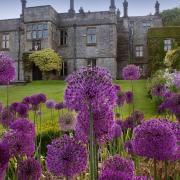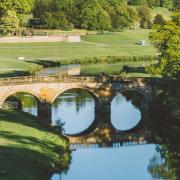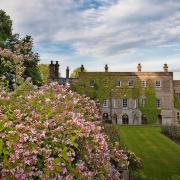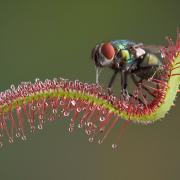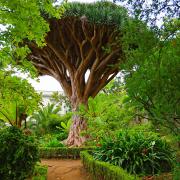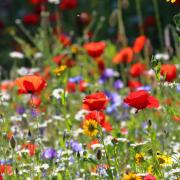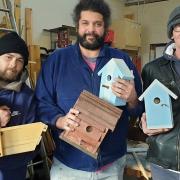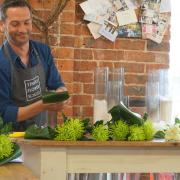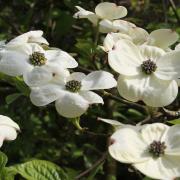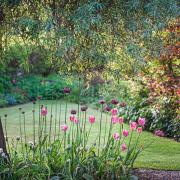Pat Ashworth visits an island of flowers on the outskirts of Derby.
Dramatic aerial pictures taken in 1976 of David and Rosemary Noblet's home at Findern show an island of habitation in a sea of fields. The white house at its centre is a plain 1930s design, surrounded by the ramshackle and unlovely outbuildings of the smallholding that existed here. The surrounding countryside looks as though it goes on for ever. The couple are glad to have the pictures as a memento, taken by chance weeks after they arrived. The opening of the A50 in 1997 changed the landscape in this part of Derbyshire for ever, bisecting fields where cattle used to graze and isolating lands on the other side of the highway. The distant hum of the traffic is a constant reminder of its presence but it is part of the fabric for Findern residents, and in the Noblets' garden, is almost drowned by birdsong.Despite its drawbacks - the property wasn't even on mains water when they bought it - they were attracted to Clover Mead by its south-facing position on the edge of the village. 'We always say this is the nicest spot in Findern,' says Rosemary with contentment, adding of development in general, 'If the choice came of a road or a housing estate round us, give us the road any time.' The couple still own a large field adjacent to the house, where a retired farmer keeps a small herd of cows, but sold other land and gave up their own livestock when the road went through.David and Rosemary might rue the unimpeded distant view they used to have but they have made the most of a unique opportunity to create a new environment almost from scratch. They have given up breeding dogs, though they still run boarding kennels for their regulars, and in tandem with continuing to extend and beautify the house, devote most of their time to a flourishing cottage garden in a constant state of evolution.There was no master plan when they began work in 1999, and there still isn't. When they took down the outbuildings nearest the house, David eyed up the space formerly covered by a concrete yard and decided to put a pond there. 'The rest just snowballed,' he says, pleased. The couple grow a lot of things from seed, and if they see plants that they like, will buy them - often at a bargain price - and then find a place for them. Green fingers do the rest. The plant stall at Bakewell market is a favourite source, and they don't scorn a 50p bargain from B&Q if they take a fancy to it - 'We either grow it ourselves, or it's cheap.'Sometimes a plant comes up and they have no idea where they bought it. One year, Rosemary had so many tomato plants that she scattered a few among the flowers. 'Why not? It's how they did it years ago, mixing their flowers and vegetables together,' she suggests. 'I don't like uniform - the lovely thing about this garden is that especially when the plants have grown very tall, you can wander around and keep discovering things.'Friends know who to ask when they hear of a plant that might be going to waste. Seven flourishing pots of agapanthus testify to the Noblets' reviving powers: these were rescued by Rosemary's father from a friend of his who was taking them to the tip because they had got too big. 'My daughter would like those...' he ventured, and he was right. A well-established hibiscus came to them via a similar rescue route and has also thrived.'There's a profusion of clematis in the garden, the deeply scented, late-flowering Rubromarginata a particular favourite with its delicate flowers and heady perfume on a summer's evening. Arbours, arches and gazebos proliferate in this garden and clematis is spoiled for choice where to climb and twine. It turns a path into a tunnel; rambles over the house exterior to mature the original building into looking almost Victorian; and prettifies and camouflages the only remaining outbuilding, a long, low tool shed.Working areas of the garden include a plot where the couple grow vegetables from seed, including beetroot, swede, turnip cabbage and leeks. There's purple sprouting broccoli in abundance and a large potato patch. Sweet peas from seed are a favourite, tall raspberry canes will be laden with the late fruit, Autumn Bliss, and apple, pear and plum trees set in the 1980s are thriving in an orchard area at the very bottom of the garden invisible from the house.They don't pull out the forget-me-not that springs up underfoot, and Rosemary has planted out clumps of cowslips that derived from a little patch that appeared in the lawn. An exquisite display of rare Crimson Showers roses testifies to David's tenacity in hunting down this, his favourite variety. He had to dig one out when he built a kitchen extension, and went 'everywhere under the sun' to find a replacement, before discovering just two plants at a garden centre in Tenby.On a jaunt to the Cotswolds, an old book in the cottage where the couple were staying provided the know-how on how to propagate roses. 'Now I've got 20,' he says with satisfaction. 'They have hundreds and hundreds of little red flowers, absolutely beautiful. It's one of the best rambling roses I've ever seen, yet you can never find it.' He is a lover of the Kiftsgate variety too, a white rose with abundant blooms.Cattle in the field obligingly make a tableau glimpsed through an archway at the western perimeter of the garden. David and Rosemary created this arch for their daughter Verity's wedding in 2006, with blue clematis and blue delphiniums to harmonise with the theme. A timber bench nearby is a new addition - 'That was a tree last week,' David observes. 'We had to take it down because we're building another extension, so I sliced the trunk up and made the bench. We don't like to waste anything: this is a garden that uses everything we can.'David is trying his hand at a spot of topiary. 'He's trying to produce a cat,' Rosemary says helpfully, tracing the outline of the ears and face of the animal, sitting on its haunches. We stand back for a better view and agree that it's beginning to take shape. Damson trees cluster in this part of the garden, an old variety taken from an orchard beyond the cattery and transplanted alongside the hedge, yielding a harvest of fruit that Rosemary freezes and makes into damson wine.The couple do all the work in the garden and on the building themselves, an outdoor life that clearly suits them. David is fanatical about dead-heading the flowers, on which he'll spend hours in summer, but they're happy to leave the garden dormant throughout the winter and let the birds pick at the seeds. 'We start in March and clear it all up, and we never go away in the summer,' David says, reflecting, 'Why would we want to? Everything we love is here.'Piles of logs testify to the preservation of timber from old trees that have had to come down, but they've planted 500 saplings since they began the garden project. The front of the house is shielded by trees and abundant with roses, ferns and hostas. Geraniums and fuchsias adorn the porch area. The eastern side of the house sports the nearest thing to a formal lawn, where an ornamental lamp stands as though planted in a flowerbed.Visitors on NGS Open Garden days find it a wonderful escape. 'We always put a gazebo in the field as an extra place to sit. One year, a lady and her friend sat in that particular spot the whole afternoon,' Rosemary remembers. 'They told me, "We come from the middle of Burton and it's like a day out. It's wonderful." That's a real encouragement,' she says. 'It's lovely to be able to create something for people to enjoy.'Clovermead is open for the NGS on Sunday 27th July and Sunday 10th August, 2 to 5pm. More open gardens on page 90.





